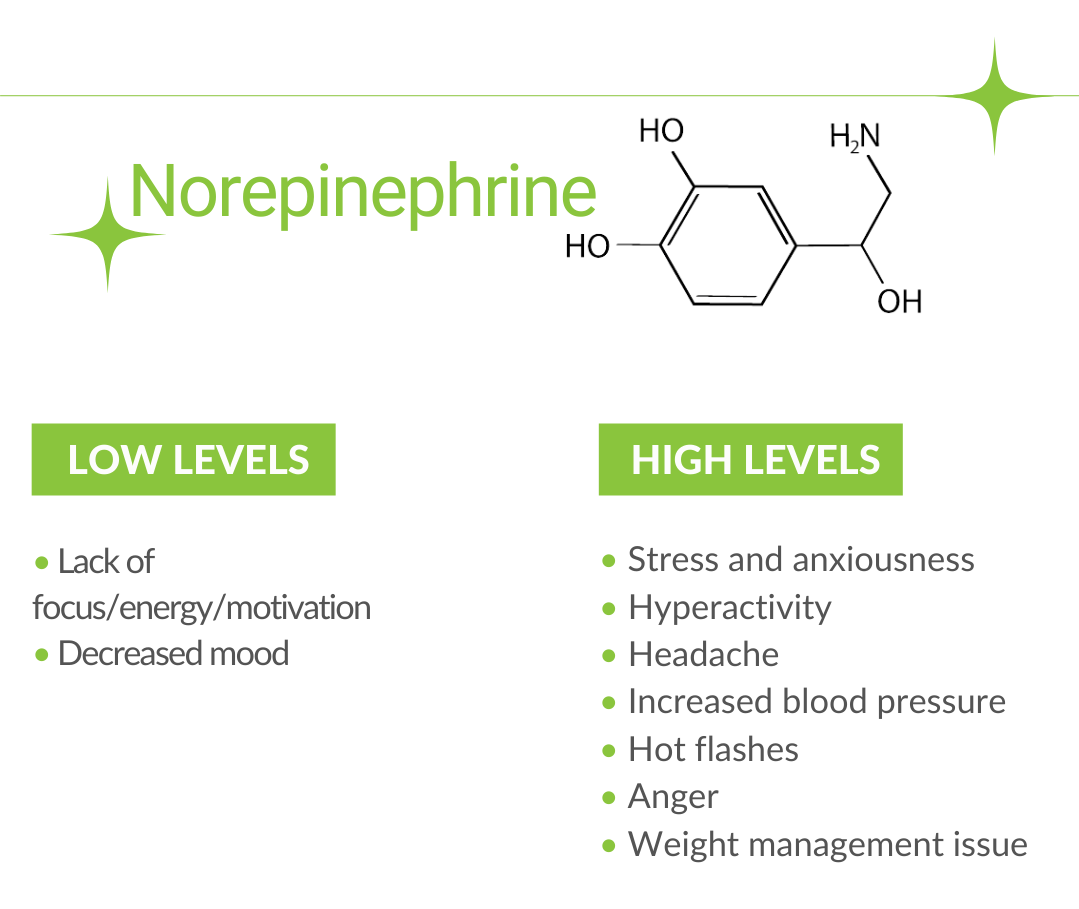Most of us have heard of adrenaline, but what is noradrenaline? And, what is its purpose? The following illustration, and its name, provide some clues.
On the plains of Africa, a gazelle is being chased by a lion. The gazelle runs for its life – its stress hormones shoot up to make sure it has blood sugar and blood pressure enough to flee! Air passages dilate to bring more oxygen; its strength increases with more blood flow to muscles, while blood flow to its gut is reduced. The gazelle has a full-blown stress response. (Fortunately, this one escaped.)
Noradrenaline: A Stress Response Hormone
Let’s look at those stress hormones. The most famous one is adrenaline, also known as epinephrine (EPI), which is produced in the adrenal glands. The gazelle’s brain recognized danger and sent a quick message to the adrenals. EPI surged into the gazelle’s bloodstream, initiating a huge stress response to ensure its survival. EPI’s partner is norepinephrine (more commonly called “noradrenaline,” outside of the U.S.) Norepinephrine (NE) and EPI both raised the gazelle’s blood sugar,1,2 blood pressure,3,4 and heart rate5 – helping to save its life. The other stress hormone, cortisol, rises in the bloodstream for inflammation control about 15 minutes after the beginning of any stressful situation.6
When we humans get stressed, our EPI, NE, and cortisol also shoot into the bloodstream to increase our blood sugar, blood pressure, and heart rate and to inhibit digestion.7,8 They increase blood flow to our muscles to run or take action as the gazelle did. But usually, we are in a car or behind a desk. Running isn’t an option. We feel our heart pounding—we are experiencing a full-blown stress response with nowhere to run! (If we had the chance, running around the block would actually help reduce that stress response.)9
The stress response is designed to be a short-term solution to an emergency. We humans get into trouble when we encounter things that trigger our stress responses that we wouldn’t classify as an emergency. For instance, maybe there’s a co-worker or problems at home that triggers our stress response. Maybe we cannot get out from under the stressor. Perhaps we find our only option is to live with it. This means our bodies are bathed in stress chemistry: EPI, NE, and cortisol. We can sometimes have difficulty controlling our blood sugar or blood pressure. We may have a difficult time relaxing or sleeping—too much “on the alert.” Our stress hormones have become imbalanced!
EPI and NE, orchestrating our stress response, are considered hormones; they circulate in our bloodstream.10 However, they also play roles in our brain to affect our mood and ability to focus. There, we call them “neurotransmitters.” EPI is not considered a big player in the brain, but NE certainly is!
The Neurotransmitter Norepinephrine 
NE in the brain has the function of mobilizing both the brain and body for action. It is lowest during the night as we sleep, rises during the day and reaches higher levels in stressful situations. In the brain, its general function is to increase arousal and alertness,11 to promote vigilance, to focus attention and increase concentration.12 NE motivates us toward action. It is also involved in forming lasting memories.13,14 NE can improve low mood15 but can also increase anxiousness and restlessness.16,17 NE is considered an “excitatory” neurotransmitter. When NE is in balance, we can concentrate; we are motivated; we are alert.
Elevated Norepinephrine Levels
NE levels increase in response to a stressful situation. In some cases, anxiousness may result. Sleep may also be affected. Another reason NE may be elevated is that we carry a gene (MTHFR) that interferes with methylation. Methylation is an important process in many bodily tissues. Additionally, it is required to convert NE into EPI. If the body cannot methylate well, NE builds up, and EPI falls. Either way, with elevated NE, we may experience anxiousness, restlessness, irritability, and sleep issues.
Reduced Norepinephrine Levels
NE is made from two amino acids provided by the protein in our diet. Those amino acids are phenylalanine and tyrosine. A diet too low in protein may not provide enough of these building blocks, and our NE may fall. Or, a stressful life may cause us to use so much NE that we reduce the NE stores. This results in low NE levels. In our lives, we may notice more indifference to things we enjoyed or cared about, more difficulty with focus, or maybe we feel sluggish and unmotivated.18
What to do About Imbalances in Norepinephrine or Noradrenaline
To address imbalance, we first must determine if we are on the “too much” or “too little” end of the spectrum. Self-observation can be useful, but in order to accurately measure our NE level, we can test for it using NeuroLab’s urine and saliva HPA test for stress hormones and neurotransmitters. If you do not have a provider, we can help you find one.
You can support healthy norepinephrine levels with a diet that has optimal protein to provide building blocks. Sometimes, diet is not enough. Using supplementation from Sanesco’s Targeted Nutritional Therapy™ line can support healthy NE levels. Balance is an achievable goal! Go for it!
References
-
Connolly CC et al. The American Journal of Physiology. 1991;261(6 Pt 1):E764-772. doi:10.1152/ajpendo.1991.261.6.E764
-
Park S-H, et al. Neuroscience Letters. 2016;620:121-126. doi:10.1016/j.neulet.2016.02.055
-
Jamerson KA, et al. Hypertension. 1994;23(6_pt_2):1006-1011. doi:10.1161/01.hyp.23.6.1006
-
Foulon P, et al. Annals of Translational Medicine. 2018;6(S1):S25-S25. doi:10.21037/atm.2018.09.27
-
Adrenal Hormones. www.endocrine.org. https://www.endocrine.org/patient-engagement/endocrine-library/hormones-and-endocrine-function/adrenal-hormones
-
Hannibal KE, et al. Physical Therapy. 2014;94(12):1816-1825. doi:10.2522/ptj.20130597
-
Tsukada F, et al. Biological & Pharmaceutical Bulletin. 2003;26(3):368-370. doi:10.1248/bpb.26.368
-
Nezami BG, et al. Current Gastroenterology Reports. 2010;12(5):358-365. doi:10.1007/s11894-010-0129-9
-
MAYO Clinic. Exercise and stress: Get moving to manage stress. Mayo Clinic. Published August 18, 2020. https://www.mayoclinic.org/healthy-lifestyle/stress-management/in-depth/exercise-and-stress/art-20044469#:~:text=Exercise%20increases%20your%20overall%20health
-
Rogers K. norepinephrine | Definition, Function, Effects, & Facts. In: Encyclopædia Britannica. ; 2019. https://www.britannica.com/science/norepinephrine
-
Berridge CW, et al. Sleep Medicine Reviews. 2012;16(2):187-197. doi:10.1016/j.smrv.2011.12.003
-
Schwarz LA, et al. Current Biology. 2015;25(21):R1051-R1056. doi:10.1016/j.cub.2015.09.039
-
Kumar A, et al. Journal of Pharmacy and Bioallied Sciences. 2013;5(2):91. doi:10.4103/0975-7406.111818
-
Roozendaal B, et al. Behavioral Neuroscience. 2011;125(6):797-824. doi:10.1037/a0026187
-
Briley M, et al. Neuropsychiatric Disease and Treatment. 2011;7:9. doi:10.2147/ndt.s19619
-
Baldwin DS. International Journal of Psychiatry in Clinical Practice. 2006;10(sup2):12-15. doi:10.1080/13651500600637056
-
Morris LS, et al. Brain and Neuroscience Advances. 2020;4. doi:10.1177/2398212820930321
-
Hezemans FH, et al. medRxIv Preprint. 2021 July 26. https://doi.org/10.1101/2021.07.04.21259922;



